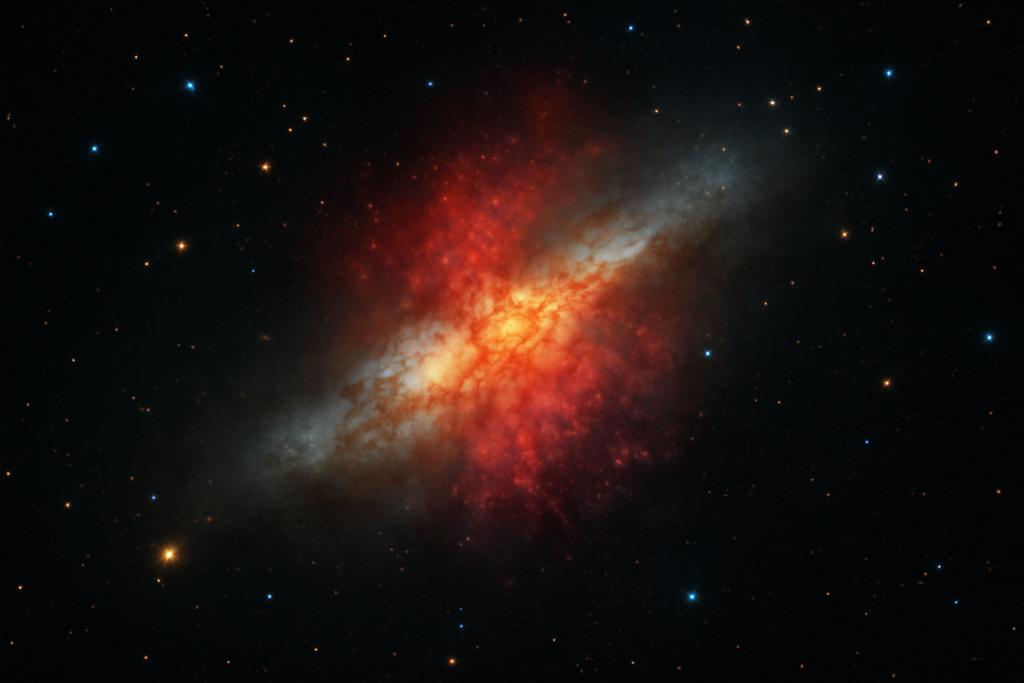The galaxy M82, a vibrant starburst galaxy, has long captivated astronomers with its intense star formation and energetic emissions. But recent findings, based on years of data from the Fermi Gamma-ray Space Telescope and the Very Energetic Radiation Imaging Telescope Array System (VERITAS), paint an even more dynamic picture. A new study from researchers at the Istituto Nazionale di Astrofisica, Padova Astronomical Observatory, the University of Padova, and Tel Aviv University, led by Massimo Persic, Riccardo Rando, and Yoel Rephaeli, has unveiled a hidden powerhouse of protons within M82’s core, revealing a surprising interplay of cosmic rays and radiation that sheds light on the galaxy’s inner workings.
Unveiling the Proton Powerhouse
The heart of M82, its central starburst region (CSB), is a maelstrom of activity. Supernovae explode at a furious rate, creating shock waves that accelerate particles to near-light speed, generating cosmic rays (CRs) – high-energy protons and electrons. These CRs interact with the dense gas and radiation fields within the CSB, producing a cascade of emissions across the electromagnetic spectrum, from radio waves to gamma rays.
Previous studies focused on individual aspects of this cosmic show. They examined radio emissions, X-rays, and gamma rays separately, offering glimpses into different aspects of the energy production. But what makes this new study groundbreaking is its holistic approach. The researchers developed a sophisticated model that self-consistently integrates the observed emission data across the full range – radio, X-ray, and gamma ray – to infer the underlying physical processes and the properties of the CR populations.
The researchers discovered a key piece of the puzzle in recently detected diffuse non-thermal X-ray emission. The X-rays’ spatial distribution mirrored that of the radio and far-infrared emissions, indicating a common origin. The researchers realized that these X-rays were likely generated through Compton scattering: radio-emitting electrons were scattering off the far-infrared radiation field. This provided them with a unique calibration point to constrain their models.
A Symphony of Cosmic Rays and Radiation
By integrating data across the entire spectrum, the researchers discovered that M82’s gamma rays — the most energetic emission—primarily stem from the decay of neutral pions (π0), particles produced when high-energy protons collide with the interstellar gas. This confirms that the CSB is a significant source of proton acceleration. This pionic component dominates the high-energy gamma-ray emissions measured by VERITAS.
However, the story isn’t just about protons. At lower energies, gamma-ray emissions are dominated by the Compton scattering of starlight and far-infrared photons by electrons. This intricate interplay of proton-dominated and electron-dominated emissions at different energy levels showcases the complexity of the CSB’s particle acceleration processes.
The radio emission, primarily from synchrotron radiation by electrons, offered another crucial constraint. The model allowed the researchers to directly infer the magnetic field strength within the CSB, without relying on the often-unreliable assumption of energy equipartition (a balance between particle and magnetic field energies). This direct magnetic field measurement yielded values around 120 microgauss, which is strikingly close to estimates based on the equipartition assumption, adding confidence to the overall accuracy.
Implications for Galaxy Evolution
This study’s insights extend beyond the specific features of M82. The research provides critical details about the mechanisms that drive energy production in starburst galaxies. The method of combining broadband emission data to deduce CR properties and magnetic field strengths is a significant advancement for the field. By understanding these mechanisms, we can better understand how galaxies evolve and how they regulate their star formation.
Furthermore, this research helps us understand the conditions required for generating the most energetic emissions—in this case, the high-energy gamma rays from π0 decay—that act as valuable probes into the workings of the most energetic regions of the universe. It demonstrates the crucial role of high-energy protons in the overall energy budget of starburst galaxies, highlighting these regions as not just stars’ factories but also cosmic-ray accelerators on a galactic scale.
The researchers acknowledge that several uncertainties remain, particularly regarding the exact properties of the far-infrared radiation field. Further observations and refinements to the models could lead to even more precise measurements and an even deeper understanding of M82’s cosmic fireworks. This work suggests a future direction for research, using combined analyses of multi-wavelength data to gain insights into the complexities of particle acceleration and energy transport in diverse galactic environments. The implications extend far beyond a single galaxy, potentially altering our understanding of how cosmic rays are produced across the universe.










